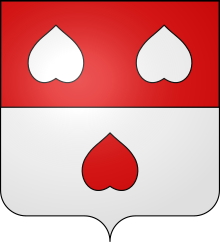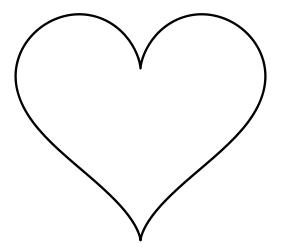Heart symbol
This article needs additional citations for verification. (August 2010) |


The heart (♥) has long been used as a symbol to refer to the spiritual, emotional, moral, and in the past, also intellectual core of a human being. As the heart was once widely believed to be the seat of the human soul, the word heart continues to be used poetically to refer to the soul, and stylized depictions of hearts are used as prevalent symbols representing love.
As metaphor
In mythology and religion

In religious texts the heart was historically ascribed much mystical significance, either as metaphor or as an organ genuinely believed to have spiritual or divine attributes.[citation needed]
In Egyptian mythology, the heart portion of the soul was weighed in a balance against the feather of Ma'at, symbolising truth, in the judgment of the dead in the Egyptian Book of the Dead. Egyptian sources do not actually reveal whether the heart had to be lighter than the feather for the deceased to pass into paradise—all depictions show only the weighing of the heart, not the actual results, heavier or lighter.
Similarly, in the Bible, this idea emerges in the earliest passages; Genesis 6:5 situates the thoughts of evil men in their hearts, and Exodus 5 through 12 speak repeatedly of the Lord "hardening Pharaoh's heart." By this it is meant that God made Pharaoh resolve not to let the Israelite slaves leave Egypt, in order to bring judgment against Pharaoh and demonstrate his power: "'Go to Pharaoh, for I have hardened his heart and the hearts of his officials so that I may perform these miraculous signs of mine among them'" (Exodus 10:1). In the Book of Jeremiah 17:9, it is written that the Lord is the judge who "tries" the human heart.
The Sacred Heart of Jesus and the Immaculate Heart of Mary are traditional Roman Catholic devotional images.
In early science and philosophy
Many classical philosophers and scientists, including Aristotle, considered the heart the seat of thought, reason or emotion, often rejecting the value of the brain.[1]
The Stoics taught that the heart was the seat of the soul.
The Roman physician Galen located the seat of the passions in the liver, the seat of reason in the brain, and considered the heart to be the seat of the emotions. While Galen's identification of the heart with emotion were proposed as a part of his theory of the circulatory system, the heart has continued to be used as a symbolic source of human emotions even after the rejection of such beliefs.[2]
These themes were reiterated in the European Middle Ages.
As an icon

In European traditional art and folklore, the heart symbol is drawn in a stylized shape. This shape is typically coloured red, suggesting both blood and, in many cultures, passion and strong emotion. The hearts have constituted, since the 15th century, one of the red suits in most playing card decks. The shape is particularly associated with romantic love; it is often seen on St. Valentine's Day cards, candy boxes, and similar popular culture artifacts as a symbol of romantic love.
What the traditional "heart shape" actually depicts is a matter of some controversy.[3] It only vaguely resembles the human heart.
The seed of the silphium plant, used in ancient times as an herbal contraceptive,[4] has been suggested as the source of the heart symbol.[3][5]
The heart symbol could also be considered to depict features of the human female body, such as the female's buttocks, pubic mound, or spread vulva.[6] The tantric symbol of the "Yoni" is another example of a heart-shaped abstraction of a woman's vulva.
The heart symbol could also be derived from the shape made by swans' necks in a courting ritual, which resembles the heart shape.
Inverted heart symbols have been used in heraldry as stylized testicles (coglioni in Italian) as in the canting arms of the Colleonis of Milan.[7]
The heart symbol has been used in everything from the I Love New York ad campaign to Mad Magazine's cover image un-endorsing Barack Obama. The Oxford English Dictionary revised its entry on the symbol, changing ♥ to heart, citing that it "may be the first English usage to develop via the medium of T-shirts and bumper-stickers."
Computer code

A common emoticon for the heart is <3. In Unicode several heart symbols are available:
| Glyph | Description | HTML code | Alt codes |
|---|---|---|---|
| ♡ | U+2661 WHITE HEART SUIT | ♡ or ♡
|
Alt + 9825 |
| ♥ | U+2665 BLACK HEART SUIT | ♥ or ♥ or ♥
|
Alt + 3 |
| ❤ | U+2764 HEAVY BLACK HEART | ❤
|
|
| ❥ | U+2765 ROTATED HEAVY BLACK HEART BULLET | ❥
|
|
| ❣ | U+2763 HEAVY HEART EXCLAMATION MARK ORNAMENT | ❣
|
And from the Miscellaneous Symbols and Pictographs range associated with emoji:
| Glyph | Description | HTML code | Alt codes |
|---|---|---|---|
| 💑 | U+1F491 COUPLE WITH HEART | 💑
|
|
| 💓 | U+1F493 BEATING HEART | 💓
|
|
| 💔 | U+1F494 BROKEN HEART | 💔
|
|
| 💕 | U+1F495 TWO HEARTS | 💕
|
|
| 💖 | U+1F496 SPARKLING HEART | 💖
|
|
| 💗 | U+1F497 GROWING HEART | 💗
|
|
| 💘 | U+1F498 HEART WITH ARROW | 💘
|
|
| 💙 | U+1F499 BLUE HEART | 💙
|
|
| 💚 | U+1F49A GREEN HEART | 💚
|
|
| 💛 | U+1F49B YELLOW HEART | 💛
|
|
| 💜 | U+1F49C PURPLE HEART | 💜
|
In Code page 437, the original character set of the IBM PC, the value of 3 (hexadecimal 03) represents the heart symbol. This value is shared with the non-printing ETX control character, which overrides the glyph in many contexts.
Mathematical description
There are several mathematical descriptions that result in approximately heart-shaped curves. The best-known of these is the cardioid, which is an epicycloid with one cusp[8]. Other curves, such as the implicit curve (x2+y2−1)3−x2y3=0, may produce better approximations of the heart shape.[9]
References
- ^ Aristotle, De partibus animalium ("On the Parts of Animals"), book 3, ch. 4
- ^ Galen, De usu partium corporis humani ("The Use of the Parts of the Human Body"), book 6.
- ^ a b The Shape of My Heart: Where did the ubiquitous Valentine's symbol come from? by Keelin McDonell, Slate.com.
- ^ Pliny the Elder, XXII, Ch. 49
- ^ Sowing the seeds of love, The Age, by Luke Benedictus, February 12, 2006
- ^ Gloria Steinem wrote in her 1998 introduction to the Vagina Monologues: "For example, the shape we call a heart—whose symmetry resembles the vulva far more than the asymmetry of the organ that shares its name—is probably a residual female genital symbol. It was reduced from power to romance by centuries of male dominance."
- ^ Woodward, John and George Burnett (1969). Woodward's a treatise on heraldry, British and foreign, page 203. Originally published 1892, Edinburgh: W. & A. B. Johnson. ISBN 0-7153-4464-1. LCCN 02-0
- ^ Weisstein, Eric W., "Cardioid" from MathWorld.
- ^ Eric W. Weisstein, "Heart Curve." From MathWorld
External links
- The Heart Symbol - Origin, History And Significance by Prof. Armin Dietz
- Heart Tattoo Art Overview of the heart symbol as used in tattoo art.
- P. J. Vinken (2000), The Shape of the Heart: A Contribution to the Iconology of the Heart (illustrated ed.), Elsevier Health Sciences, ISBN 978-0-444-82987-0
- Vinken, P (2001), "How the heart was held in medieval art", The Lancet, 358 (9299): 2155–2157, doi:10.1016/S0140-6736(01)07224-5, PMID 11784647





